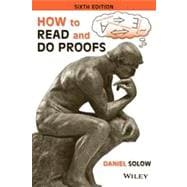
Note: Supplemental materials are not guaranteed with Rental or Used book purchases.
Purchase Benefits
What is included with this book?
Daniel Solow is a professor of management for the Weatherhead School of Management at Case Western Reserve University. His research interests include developing and analyzing optimization models for studying complex adaptive systems, and basic research in deterministic optimization, including combinatorial optimization, linear and nonlinear programming. He has published over 20 papers on both topics.
Foreword xi
Preface to the Student xiii
Preface to the Instructor xv
Acknowledgments xviii
Part I Proofs
1 Chapter 1: The Truth of It All 1
2 The Forward-Backward Method 9
3 On Definitions and Mathematical Terminology 25
4 Quantifiers I: The Construction Method 41
5 Quantifiers II: The Choose Method 53
6 Quantifiers III: Specialization 69
7 Quantifiers IV: Nested Quantifiers 81
8 Nots of Nots Lead to Knots 93
9 The Contradiction Method 101
10 The Contrapositive Method 115
11 The Uniqueness Methods 125
12 Induction 133
13 The Either/Or Methods 145
14 The Max/Min Methods 155
15 Summary 163
Part II Other Mathematical Thinking Processes
16 Generalization 179
17 Creating Mathematical Definitions 197
18 Axiomatic Systems 219
Appendix A Examples of Proofs from Discrete Mathematics 237
Appendix B Examples of Proofs from Linear Algebra 251
Appendix C Examples of Proofs from Modern Algebra 269
Appendix D Examples of Proofs from Real Analysis 287
Solutions to Selected Exercises 305
Glossary 357
References 367
Index 369
The New copy of this book will include any supplemental materials advertised. Please check the title of the book to determine if it should include any access cards, study guides, lab manuals, CDs, etc.
The Used, Rental and eBook copies of this book are not guaranteed to include any supplemental materials. Typically, only the book itself is included. This is true even if the title states it includes any access cards, study guides, lab manuals, CDs, etc.